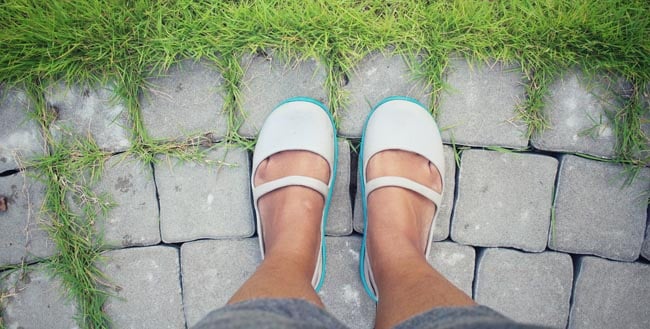Although falls are common among seniors, they're still very serious. Harvard Health Publications reports an estimated 18,000 older Americans die annually from falls sustained during a fall. When a senior falls, medical experts recommend changing the footwear as part of a fall prevention plan. Certain shoes pose a greater fall risk than others. For example, heels, flip-flops and shoes with a leather or slippery sole can lead to tripping and stumbling. Here's a guide to the proper footwear for senior fall prevention:
Elements of Senior Footwear
Knowing what to look for in a pair of shoes can help you and your senior loved one select the perfect pair of shoes. Here are a few things to look for in your footwear:
-
Soles: The midsoles of the shoes need to be sturdy and not too flexible to ensure better stability. Flexible shoes that bend too readily often cause a senior to twist their foot or ankle and fall. Hard, sturdy soles are more slip-resistant than lightweight, flexible shoes. Choose shoes that have a good tread, and get rid of shoes that have worn out tread.
-
Size: The shoes need to fit correctly. If the shoes are too big, the senior's foot will slip and slide within the shoe and can contribute to a fall or loss of balance. Shoes that are too tight cause foot pain which makes it difficult for the elderly person to walk and focus on each step.
-
Closed Heels: Seniors should wear closed-heel shoes for greater stability. Open heeled shoes frequently do not fit snug enough and the person's foot will slide in the shoe which may create instability or balance problems.
-
Weight: Heavy shoes are a problem for weak seniors. They can have trouble lifting their feet up so they tend to shuffle when they walk which can cause falling. The heels of the shoe should also not be more than an inch thick. Low-heeled shoes provide greater stability.
-
Sole Material/Design: A sole that is too smooth is slippery and a sole with too much tread grabs at the ground, which often makes the wearer stumble. Ideally, the soles need to be made of slip-resistant material and tread.
-
Low Heel: Wearing a high heel is bad for posture, balance and negatively affects gait. Combine these and there is a significantly increased risk of a fall. Therefore only a low heel is recommended.
Best Shoe Types
It's important to have a variety of types of shoes around to match your lifestyle. Here are a few types of footwear that seniors will want to have.
-
Walking Shoes: While you may think the thick, chunky-sole athletic shoes are considered "sensible" shoes, they may actually be the culprit behind the falls. The thick sole impairs the ability to walk and maintain balance. Shoes that claim to feel like "you're walking on air" are dangerous to seniors. Opt for a walking shoe without rubber over the toes. Walking shoes typically provide the right amount of traction seniors need. Look for a thin sole that allows your loved one to feel the sensation as he walks. This will help him better stabilize himself as he steps.
-
Shoes Without Laces: Seniors need shoes that fit properly. Shoes that lace are easier to adjust to the correct fit than shoes that Velcro or slip on the feet. If the senior is lacking dexterity, look for shoes with elastic laces that can be adjusted to firmly secure the foot, but allow the senior to easily get the shoes on and off.
-
Customized Orthotics: Over-the-counter orthotics can help relieve pressure and foot pain and may help balance. If the senior has structural foot problems resulting from diabetes or arthritis, she may need customized orthotics to insert in her shoes. The cost of custom orthotics is around $400, but insurance may help with some of the costs.
-
Around-the-House Footwear: In addition to paying attention to what is worn outside the home, focus on what is worn at home as well. If your loved one likes to walk around with socks on be sure to provide pairs that have grips on the bottom. The grips will increase traction and help prevent them from falling especially on tile or wood flooring.
Specific Shoes For Seniors
If you are looking for some examples of amazing senior footwear, we've got you covered!
-
New Balance 990: A little expensive but will last longer. Good, comfortable shoe with great heel stability. Different colors to choose from so it never gets boring.
-
Rockport’s XCS Walk Together Mudguard: Has a great heel stabilizer with added cushioning and a rubber outsole that provides a slip-resistant, durable grip. It also has a flexible and lightweight midsole.
-
Propét® Tasha: More of a mid-range shoe in terms of price but is not lacking in safety or comfort. It’s perfect for all-day wear with a rubber outsole for durable traction. Features a unique U-shaped design built into the sole that helps support a natural gait.
-
Saucony ProGrid Guide: Another mid-range shoe. A flatter shoe but one that allows the walker to achieve a good heel plant and rolling step. Provides good stability and comes in both medium and wide widths.
-
Skechers for Work Women's 76492 Compulsions Chant Work Shoe: The most economical of the bunch. Comfortable, durable, and super slip-resistant. Offers a supportive rubber sole and breathable mesh. These shoes have faux laces that make them easy to put on and take off. There is also a men’s version of this shoe.
Make sure when trying on shoes to do so in the afternoon when your foot often swells and to test different widths for the best fit. Walk around in them for at least 5-10 minutes to really try them out.
For more information on fall safety, review our Fall Prevention Fact Sheet.


